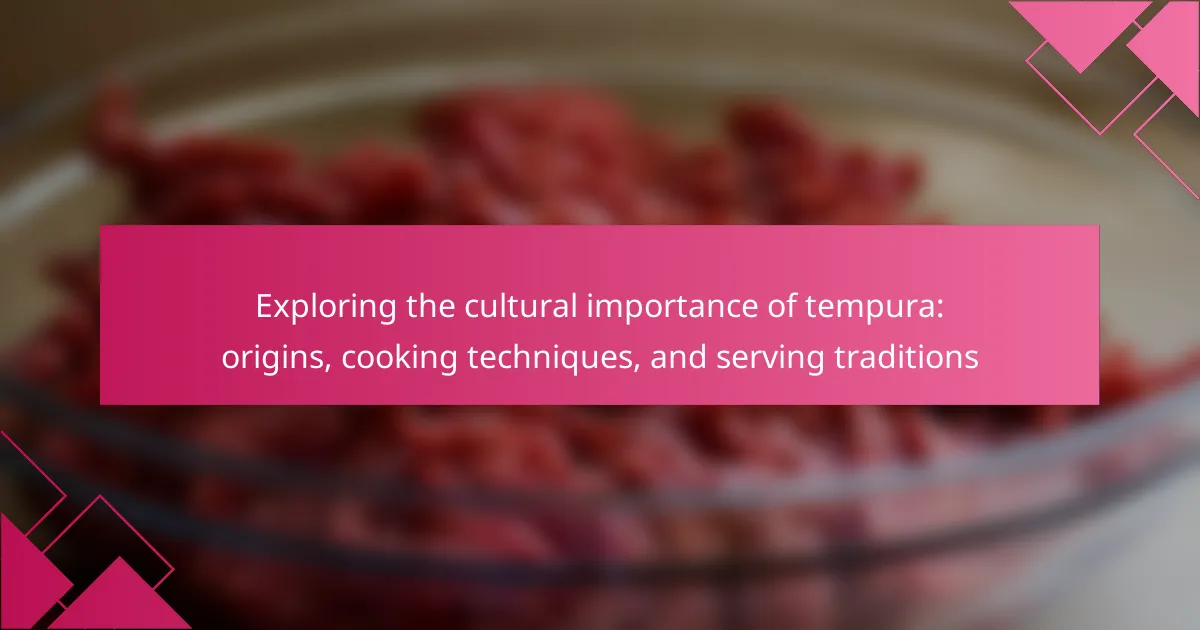
What is the cultural significance of tempura?
Tempura holds significant cultural importance in Japan. It represents a fusion of culinary traditions, influenced by Portuguese missionaries in the 16th century. The technique of frying vegetables and seafood in batter became popular in Japanese cuisine. Tempura is often associated with seasonal ingredients, reflecting the Japanese appreciation for nature. It is commonly served during festivals and special occasions, symbolizing celebration and community. The dish emphasizes simplicity and freshness, aligning with the Japanese aesthetic of wabi-sabi. Additionally, tempura has become a staple in Japanese restaurants worldwide, showcasing its global cultural impact.
How did tempura originate in Japan?
Tempura originated in Japan during the 16th century. Portuguese missionaries and traders introduced the technique of frying food in batter. This method was adapted by Japanese cooks, leading to the creation of tempura. The term “tempura” is derived from the Latin phrase “tempora,” referring to the times of Lent when certain foods were fried. Over time, tempura evolved into a distinctive Japanese dish. It became popular as a street food in Edo (modern-day Tokyo). The dish typically features seafood and vegetables coated in a light batter and deep-fried. Today, tempura is celebrated as a significant part of Japanese cuisine.
What historical influences shaped the development of tempura?
Tempura was influenced by Portuguese cooking techniques introduced to Japan in the 16th century. The method involved battering and deep-frying seafood and vegetables. This technique was adapted by Japanese cooks over time. The term “tempura” is derived from the Latin word “tempora,” referring to the Ember Days when Catholics abstained from meat. As tempura evolved, it incorporated local ingredients and flavors. By the Edo period, tempura became popular as a street food in Tokyo. Its preparation methods and presentation further developed during this era. Tempura’s historical influences reflect a blend of foreign and Japanese culinary traditions.
In what ways did tempura evolve over time?
Tempura evolved significantly from its origins in the 16th century. Initially introduced to Japan by Portuguese missionaries and traders, it was a method of frying food in batter. The technique was adapted over time to incorporate local ingredients and preferences. By the Edo period, tempura became a popular street food in Japan. The batter evolved to become lighter and crispier, enhancing the dish’s appeal. Different regions of Japan began to develop their unique styles of tempura. Today, tempura is recognized as a refined culinary art, often served in high-end restaurants. Its evolution reflects cultural exchanges and adaptations throughout Japanese history.
Why is tempura considered an important dish in Japanese cuisine?
Tempura is considered an important dish in Japanese cuisine due to its unique cooking technique and cultural significance. The dish originated in the 16th century, influenced by Portuguese cooking methods. Tempura showcases seasonal ingredients, highlighting Japan’s appreciation for fresh produce. The light batter used in tempura allows for the natural flavors of vegetables and seafood to shine. It is also a symbol of refinement and skill in Japanese culinary arts. Tempura is often served at special occasions and festivals, reinforcing its cultural relevance. This dish has become a staple in both home cooking and restaurants across Japan. Its popularity has even spread internationally, showcasing its global appeal.
What role does tempura play in traditional Japanese meals?
Tempura serves as a popular dish in traditional Japanese meals. It consists of battered and deep-fried seafood and vegetables. Tempura is often enjoyed as part of a multi-course meal known as kaiseki. It enhances the dining experience with its light and crispy texture. The dish highlights seasonal ingredients, showcasing freshness and quality. Tempura is usually accompanied by dipping sauces like tentsuyu. This adds flavor and complements the dish’s delicate nature. Historically, tempura was introduced to Japan by Portuguese missionaries in the 16th century. Its integration into Japanese cuisine reflects cultural exchange and adaptation.
How does tempura reflect Japanese culinary values?
Tempura reflects Japanese culinary values through its emphasis on simplicity and seasonality. The dish showcases fresh, seasonal ingredients, highlighting the Japanese appreciation for nature’s bounty. Tempura’s light batter exemplifies the value placed on texture and presentation in Japanese cuisine. The cooking technique, which involves quick frying, preserves the natural flavors of the ingredients. This method aligns with the Japanese principle of “umami,” enhancing the overall taste experience. Tempura is often served with dipping sauces, emphasizing balance and harmony in flavors. The communal aspect of sharing tempura reflects the importance of togetherness in Japanese dining culture. Overall, tempura embodies key Japanese culinary values such as simplicity, respect for ingredients, and harmony in dining experiences.

What are the essential cooking techniques for tempura?
The essential cooking techniques for tempura include batter preparation, ingredient selection, and frying method. The batter is made from a mixture of cold water and flour. This batter should be lumpy to create a light texture. Ingredients typically include vegetables and seafood. These should be cut into uniform sizes for even cooking. The frying method requires hot oil, ideally around 350°F to 375°F. This high temperature ensures a crispy exterior while maintaining moisture inside. Frying should be done in small batches to prevent temperature drops. These techniques contribute to the distinctive light and crispy texture of tempura.
How is the batter for tempura made?
Tempura batter is made by combining cold water, flour, and sometimes egg. The water should be very cold to create a light texture. The flour used is typically all-purpose or cake flour. Mixing should be brief to avoid gluten development. The batter should remain lumpy for optimal crispiness. Some variations include adding cornstarch for extra crunch. This method ensures a delicate coating that fries well. The technique is rooted in Japanese culinary traditions, emphasizing texture and flavor.
What ingredients are commonly used in tempura batter?
Tempura batter commonly consists of flour, water, and egg. The flour used is typically all-purpose or cake flour. Water is usually cold, which helps achieve a light and crispy texture. Egg is added to provide richness and binding. Some variations may include cornstarch for extra crispiness. These ingredients combine to create a delicate coating that enhances the flavor of the ingredients being fried. The use of cold water is essential, as it prevents gluten formation, resulting in a lighter batter.
What is the significance of batter consistency in tempura preparation?
Batter consistency is crucial in tempura preparation. It affects the texture and flavor of the final dish. A light and airy batter results in a crispy coating. This enhances the overall eating experience. If the batter is too thick, it becomes heavy and greasy. This can overshadow the delicate flavors of the ingredients. Proper consistency allows for even cooking and browning. Research shows that a 1:1 ratio of flour to cold water is ideal for tempura batter. This ensures the right balance of moisture and air.
What frying methods are used for tempura?
The primary frying method used for tempura is deep frying. In this technique, ingredients are submerged in hot oil, typically at temperatures around 350°F to 375°F. This high temperature creates a light and crispy texture. The batter used for tempura is made from a mixture of flour, water, and sometimes egg. It is important to keep the batter cold to achieve the desired crispiness. The deep frying method allows for quick cooking, preserving the freshness of the ingredients. Traditional tempura often features seafood and vegetables, showcasing the variety of textures and flavors. This method has been a staple in Japanese cuisine since the 16th century.
How does oil temperature affect the quality of tempura?
Oil temperature significantly affects the quality of tempura. Proper oil temperature ensures a crispy texture and retains the food’s moisture. If the oil is too hot, the exterior may burn before the interior cooks. Conversely, if the oil is too cool, the tempura absorbs excess oil, resulting in a greasy texture. Ideal frying temperatures for tempura range from 170°C to 180°C (340°F to 360°F). At this range, the batter cooks quickly, leading to a light and airy finish. Studies show that maintaining this temperature balance is crucial for achieving authentic tempura quality.
What types of oils are best for frying tempura?
The best oils for frying tempura are those with high smoke points and neutral flavors. Common choices include vegetable oil, canola oil, and peanut oil. These oils can withstand the high temperatures required for frying without burning. For instance, peanut oil has a smoke point of around 450°F (232°C). This makes it suitable for achieving the crispy texture desired in tempura. Canola oil and vegetable oil also have smoke points above 400°F (204°C). Their neutral flavors allow the taste of the tempura ingredients to shine through.

What are the traditional serving practices for tempura?
Tempura is traditionally served with a few specific practices. It is commonly accompanied by dipping sauces, such as tentsuyu, which is a mixture of dashi, soy sauce, and mirin. Tempura is often presented on a tray or plate, arranged aesthetically to highlight its visual appeal. It is typically served immediately after frying to maintain its crispiness.
In Japan, tempura is often enjoyed with rice and miso soup as part of a set meal. The dish can also be garnished with grated daikon radish or shichimi togarashi for added flavor. Traditionally, diners are encouraged to eat tempura with chopsticks. This practice underscores the importance of presentation and the dining experience in Japanese culture.
How is tempura typically served in Japan?
Tempura is typically served in Japan alongside a dipping sauce called tentsuyu. The sauce is made from dashi, soy sauce, and mirin. Tempura is often accompanied by grated daikon radish. It may also be served with rice or noodles as part of a meal. Presentation is important; tempura is usually arranged on a plate to highlight its crispiness. In some settings, it is served in a bento box. Tempura can be enjoyed as a main dish or as a side dish. This serving style reflects the Japanese emphasis on aesthetics and balance in meals.
What accompanying sauces or dips are commonly used with tempura?
Tempura is commonly served with dipping sauces known as tentsuyu. Tentsuyu is made from a mixture of dashi, soy sauce, and mirin. This sauce enhances the flavor of the tempura. Another popular option is salt, often used for a lighter taste. Some people enjoy a citrus-based dip called ponzu. Ponzu adds a refreshing acidity to the dish. Each of these sauces complements the crispy texture of tempura. They are integral to the traditional serving of this Japanese dish.
What garnishes enhance the presentation of tempura dishes?
Shiso leaves enhance the presentation of tempura dishes. They add vibrant green color and a unique flavor. Daikon radish, when finely grated, provides a contrasting texture and freshness. Chopped scallions contribute both color and a mild onion taste. Edible flowers can be used for a decorative touch, elevating the visual appeal. Lemon wedges offer a bright, zesty element that complements the fried texture. These garnishes not only beautify the dish but also enhance the overall dining experience.
What cultural customs surround the consumption of tempura?
Tempura is traditionally consumed in Japan with specific cultural customs. It is often enjoyed during special occasions and festivals. Diners typically dip tempura in tentsuyu sauce, enhancing its flavor. Tempura is also served with grated daikon radish, which aids digestion. Sharing tempura among family and friends is a common practice. This communal aspect emphasizes togetherness in Japanese culture. Additionally, tempura is sometimes paired with rice or soba noodles, reflecting regional dining customs. The preparation and presentation of tempura are considered an art form in Japanese cuisine.
How do seasonal variations influence tempura serving styles?
Seasonal variations significantly influence tempura serving styles. In spring, tempura often features fresh, seasonal vegetables like asparagus and young greens. Summer servings may include lighter options, such as zucchini and eggplant, to complement warmer weather. Autumn typically highlights ingredients like sweet potatoes and mushrooms, reflecting the harvest season. Winter tempura may focus on heartier vegetables and seafood, offering warmth and comfort. These seasonal choices enhance the dish’s flavors and align with traditional Japanese culinary practices, emphasizing freshness and local ingredients. Seasonal variations also affect presentation styles, with spring and summer tempura often served with lighter dipping sauces, while autumn and winter may feature richer, warming accompaniments.
What tips can enhance your tempura cooking experience?
Use cold water for the batter. Cold water helps maintain a light and crispy texture. Mix the batter gently to avoid overworking it. Overmixing can lead to a dense coating. Choose fresh, seasonal vegetables and seafood for optimal flavor. Fresh ingredients enhance the overall taste of the tempura. Heat the oil to the right temperature, around 350°F (175°C). Proper oil temperature ensures even cooking and prevents sogginess. Fry in small batches to maintain oil temperature. Crowding the pan can lower the oil temperature and affect crispiness. Serve immediately for the best texture and flavor. Tempura is best enjoyed fresh out of the fryer.
How can you achieve the perfect crunch in your tempura?
To achieve the perfect crunch in your tempura, use cold water and a light batter. Cold water helps to create steam during frying, resulting in a crispy texture. A light batter, made with minimal flour, allows for better adherence to the ingredients and enhances crunchiness. Fry the tempura in hot oil, ideally around 350°F to 375°F. This high temperature cooks the batter quickly, preventing it from becoming greasy. Additionally, avoid overcrowding the frying pan, as this can lower the oil temperature and lead to soggy tempura. Using these techniques ensures a consistently crispy result.
What common mistakes should be avoided when making tempura?
Common mistakes to avoid when making tempura include using cold oil for frying. Cold oil leads to soggy tempura instead of a crispy texture. Another mistake is overmixing the batter. Overmixing creates gluten, which results in a dense coating. Additionally, using the wrong temperature for frying is crucial. The ideal frying temperature is between 340°F and 360°F. Frying at too low a temperature causes the tempura to absorb more oil. Conversely, frying at too high a temperature can burn the coating before the food cooks through. Not drying ingredients properly before battering is also a mistake. Excess moisture can cause the batter to slip off during frying. Lastly, overcrowding the frying pan should be avoided. Overcrowding lowers the oil temperature and leads to uneven cooking.
Tempura is a significant dish in Japanese cuisine, originating from the culinary techniques introduced by Portuguese missionaries in the 16th century. This article explores the cultural importance of tempura, its historical evolution, essential cooking techniques, and traditional serving practices. Key attributes include the emphasis on seasonal ingredients, the delicate batter preparation, and the communal aspect of sharing this dish during special occasions. Additionally, the article highlights common mistakes to avoid when making tempura and tips for achieving the perfect crunch, ensuring a comprehensive understanding of this refined culinary art.
